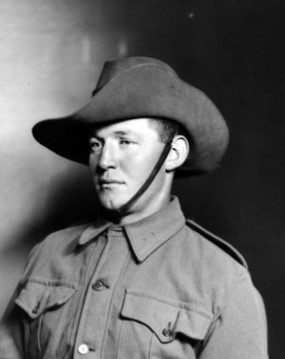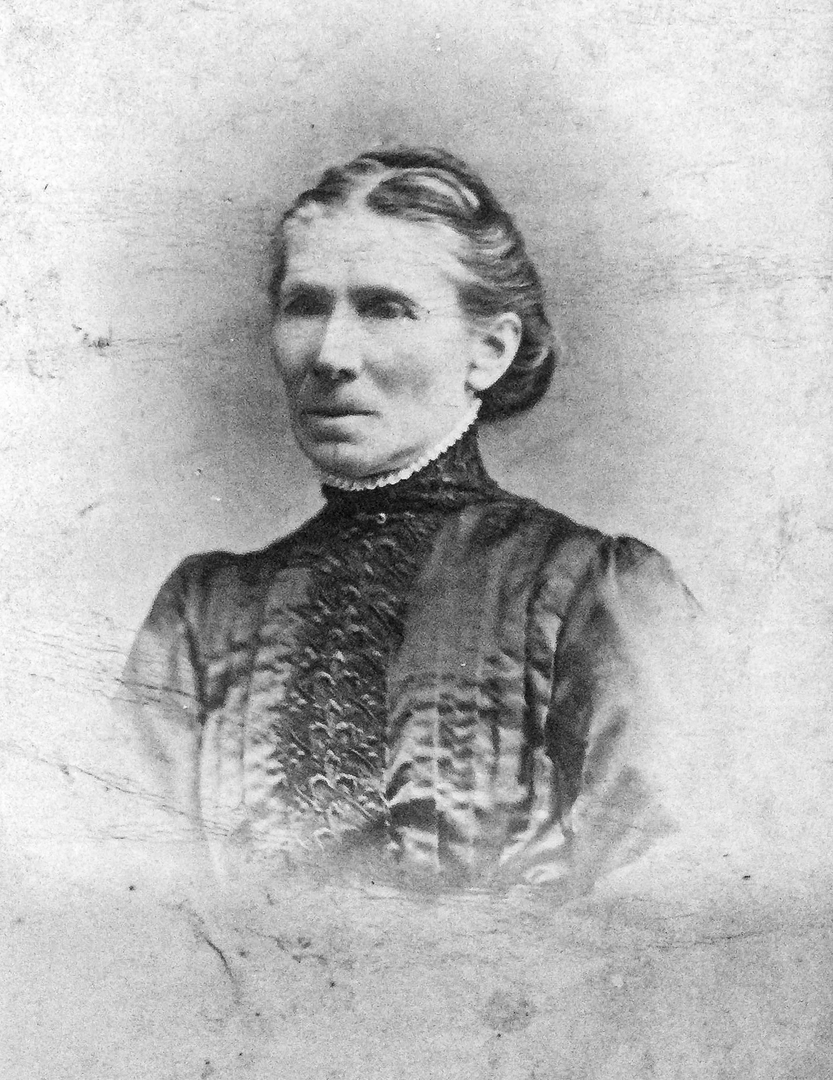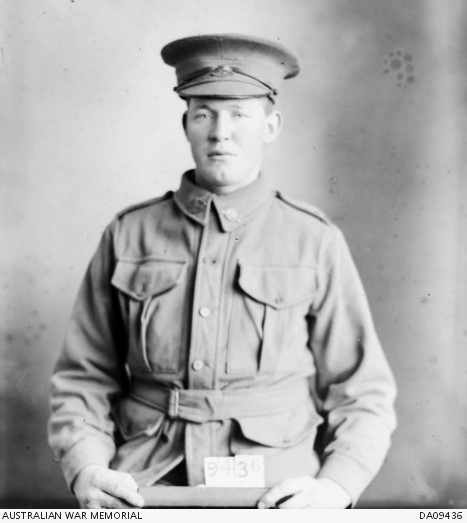Gilbert Joseph MAYO
Eyes blue, Hair light brown, Complexion fair
Gilbert Mayo - A Gippsland Boy
With gratitude to Elvie (Mayo) Gannon for the family story and for her assistance.
Gilbert Joseph Mayo enlisted to fight for his country in World War 1, eventually becoming Private 2212 in the 59th Battalion. Sadly, along with so many other young Australians, he was killed during the Battle of Fromelles on 19 July 1916.
Known to his family and friends as Gib, he was born at Thorpdale, South Gippsland in 1893. His father George (1842-1913) emigrated from Gloucestershire as a child while his mother Elizabeth Lindsay (1852-1927) was from Wales. George and Elizabeth married in Victoria 1872, living firstly in Buninyong near Ballarat, then selecting land at Childers, near Thorpdale.
Their marriage produced twelve children of which Uncle Gib was the tenth child, the sixth of eight sons. Elvie’s father, Raymond Stanley, was the 2nd youngest child:
- Elizabeth 1873
- Emeline 1874
- Henry 1876
- Frederick 1878
- Mary 1881
- Alfred 1884
- Herbert 1886
- Frank 1888
- Florence 1891
- Gilbert 1893
- Raymond 1895
- Leslie 1897

Back row from left: Gilbert 1893-1916, Leslie 1897-1987, Raymond 1895-1959, Herbert 1886-1958
Front row from left: Frederick (known as Ted) 1878-1944, Frank 1888-1955, Alfred 1884-1952.
The family all worked extremely hard, clearing the land from virgin bush, building a dwelling and eventually successfully growing potatoes there. In January 1898, the family suffered the terrible loss of their home in “The Great Gippsland Fires” with family stories recording that the fires caused George to be separated from Elizabeth and their young children for hours. Elizabeth and the children were surrounded by fire and smoke and were only able to survive by going into the creeks with running water while coals and embers showered down on them from the gum trees. Eventually, someone found them and put them on the track to the settlement.
Their mother must have been an amazingly strong woman. She insisted that the children get the best education possible, which was a local primary school – Childers State School. She was also the unofficial vet and midwife for the district in addition to running the farm, with the help of all the children.
Four of the Mayo brothers enlisted

Herbert, known as Bert, was the first to enlist, signing up in Rockhampton in December 1914 to be closely followed by Frank in January 1915. Both left Australia with their respective units in February 1915.
Gib was the next to sign up in April 1915 and left Australia in June to join troops (including Bert) fighting at Gallipoli.
A month later in July 1915, 18-year-old Leslie enlisted and went into training camp. All four sons were unmarried and had listed their mother as next of kin.
In August 1915, Elizabeth Mayo received news that Bert had been wounded at Gallipoli. He also contracted enteric fever (paratyphoid fever common amongst troops during WW1) and he returned to Australia in November 1915 for discharge as medically unfit. That same month, Leslie left Australia for overseas service.
From January 1916, three of the Mayo brothers – Frank, Gib and Les - were serving in Egypt. It is nice to think they may have had the chance to catch up at some stage. Frank was to remain in Egypt for his entire 4 years’ war service, but Gib and Les were amongst the thousands of troops who left Egypt in June 1916 for France to join the British Expeditionary Forces on the Western Front. Gib was killed at Fromelles just a month later.
Les continued to fight with his unit on the Western Front. He was wounded twice, first in September 1916 but then again more severely at the battle of Bullecourt on 11 April 1917. He was evacuated to England for treatment and returned home to Australia in July 1917.
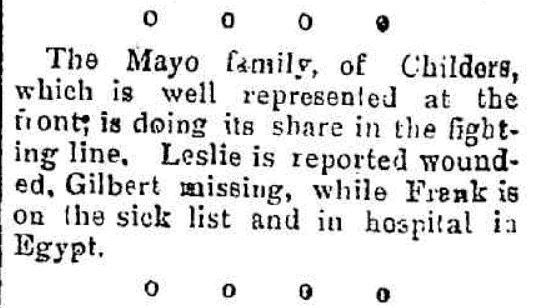
Gib’s war
Gib Mayo embarked from Melbourne, Victoria, on board HMAT A62 Wandilla on 17 June 1915. He fought with the 6th Battalion at Gallipoli including the battle of Lone Pine coming through without serious injury or illness. They arrived in Egypt on 7 January 1916 as a part of the general Gallipoli evacuation.
Early 1916 saw a major re-organisation of Australian forces with thousands of newly arrived recruits being integrated with experienced Gallipoli troops and intensive training being undertaken in Egypt. As a result, Private Gilbert Mayo, now a Gallipoli veteran, was transferred to the newly formed 58th Battalion in February 1916 but a month later was transferred to the 59th Battalion.
After some months of desert training and garrison duty, the 59th were headed for the Western Front. They boarded the ship Kinfaus Castle in Alexandria on 18 June 1916 and disembarked in Marseilles on 29 June. Gib’s younger brother Leslie had arrived in France on that same troopship some two weeks prior and Les was already in billets with the 46th Battalion preparing for the trenches on the Somme.
From Marseilles, the 59th Battalion took a train to Steenbeque, 35 kilometres from Fromelles, and continued their training – including in the use of gas masks and learning to deal with the effects of large shells. On 18 July, they were sent to the trenches to relieve the 57th Battalion. The front lines were under heavy artillery from both sides. Their position was near the Sugar Loaf salient, a prominent German machine gun emplacement.
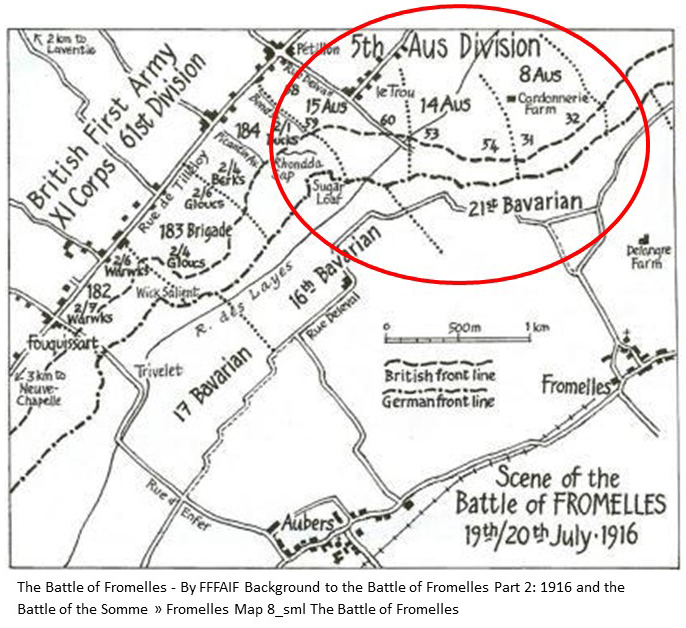
Beginning at 6.45pm on the 19th, their attack on the German lines was to proceed with four waves at 5-minute intervals. There was intense fire from rifles and machine guns just a short distance away, as documented in the messages sent back to HQ just after the attacks began – “cannot get on the trenches as they are full of the enemy and every man who rises is shot down” [see copy 15th Brigade diary entry below]. The 59th Battalion’s diary also captures the intensity of the early part of the attack where it notes that troops moved forward ‘to a point about 100 yards from the enemy trench where they were enfiladed by machine guns in the Sugar Loaf and melted away.’ [Source: AWM: 23/15/5 - 15th Infantry Brigade war diary - July 1916 – page 56]
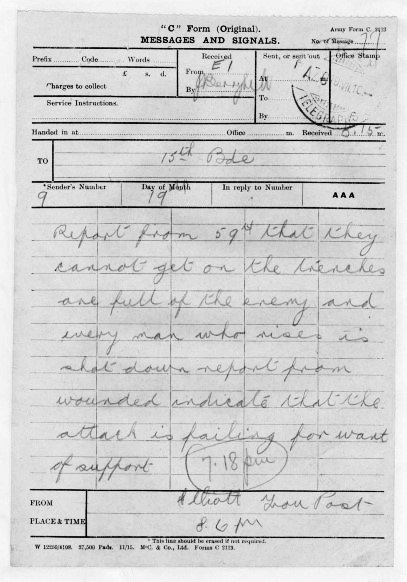
As one can well imagine, with the intensity of the battle at this particular site, there was a great deal of confusion about just how far the soldiers were able to penetrate the German lines. The official reports indicate little progress was achieved, but individuals’ reports suggest there were some advances.
The toll on the 59th was huge – 695 soldiers killed, missing or wounded.
Private Gilbert Mayo was posted as missing immediately after the battle but after enquiries were made, he was eventually found to have been killed in action on 19 July 1916. Those enquiries included evidence given to the Red Cross in October 1916 by Pte 2561 John A. Boyd who was recuperating in the General Hospital, Calais. Pte Boyd described what he knew of Gilbert’s fate on that terrible night:
“We were together in the ranks and I knew him well. In the evening about 8 o’clock, I suppose, as I was coming back I saw him lying in “No Man’s Land” about 150 yards out with his leg partly shot off. I stopped with him a long while and tried to get him away but he wouldn’t come with me and said he should try and get in. He never got in and I kicked myself for not bringing him: I had had a bit of a knock myself.”
In addition to the ‘bit of a knock’ that Pte John Boyd suffered, his younger brother, Pte 2562 Hugh Boyd, was also killed during the Battle of Fromelles.
The family back home
Around the same time that Pte John Boyd was providing evidence to the Red Cross, military authorities were processing intelligence received from German sources that confirmed Gilbert’s death and that his identity disc had been collected by the German forces. Gilbert’s name appeared on a War Office list of those killed at Fromelles and by October official cables confirmed his death “from wounds whilst prisoner of War in Germany”. The official statement was issued in January 1917.

Elizabeth was duly notified as next of kin and eventually her son’s identification disc was returned to her. After the war, she received his medals and was provided photographs of his grave and advised that her son had been buried at the Ration Farm Military Cemetery at La Chapelle-d’Armentieres with the personal inscription – Till day shall break and shadows flee. His family always remembered him and his name is also commemorated on the Thorpdale War Memorial – never forgotten.
To more recent times and the mass grave at Fromelles
With the finding of the mass grave at Fromelles, the records for many of the soldiers killed on 19-20 July 1916 have been closely investigated and the review of Gib’s file gave rise to some questions.
Firstly, his name was on what is called the ‘German death list’ which increased the probability that the soldier had been buried by the Germans in the mass grave, his identification disc and any other personal items collected (for eventual return to English military authorities via the Red Cross) and meticulous records made. There was an interesting paragraph from the 21st Bavarian Reserve papers dated 21 July 1916 showcasing the importance German authorities placed on respecting the dead, “The taking of even the most insignificant item of property from a body (German or English) constitutes robbery of the dead and will be severely punished!”.

On the other hand, Gilbert is recorded as being buried in the Ration Farm New Military Cemetery. This does not fit with the usual situation with those on the German death list. There is also a 1922 document on his file to indicate that there was some confusion as to whether the Ration Farm grave actually related to 2212 Pte Gilbert Mayo of the 59th Battalion or if it related to Pte 2644 William H. J. Mays (60th Battalion) who was also killed at the Battle of Fromelles. They were only three years apart in age but Gib was 7 inches taller and 3 stone heavier than the younger William Mays. While confused in death, they were unlikely to have been confused in life. After investigating, authorities determined that the grave belonged to Gilbert rather than to William but the evidence they relied on is not on file.
Is there a chance that Gilbert is buried at Fromelles rather than at Ration Farm? When this possibility was considered by family member, Elvie Gannon (nee Mayo), she was intrigued and embraced the challenge. She said”
`“There appeared to me that there was a strong possibility that the wrong body with a similar surname has been placed in the grave supposedly of Uncle Gib. As his niece, and with a strong emotional connection, I made contact with the Fromelles Association and the Unrecovered War Casualties section - Army . I was asked to assist with tracking down descendants who would fit the criteria to donate DNA that were needed to establish whether or not the remains of Uncle Gib were in fact buried at Pheasant Wood Cemetery.
Tracing through my cousins has been such an enjoyable journey, finding the four needed… all of whom were only too happy to donate, seems to have made Uncle Gib seem very close to us all.
The Army have delivered, retrieved and sent off the samples to the UK. Now we wait.”`
[[Elvie Gannon]]
Gib Mayo, loved and missed - we knew him too
Over the generations, the Mayo family have remained proud of the four Mayo brothers – Gib, Bert, Frank and Les – who fought in World War 1. While Gib was never to return, fortunately, Gib’s three brothers came home - although Les had been wounded. Elvie recalls her Uncle Les laughingly telling her that he was given the nickname ‘Elsie’, because of his initials (Leslie Charles).
The loss of their much-loved brother Gib affected not only his parents and siblings, but also the wider close-knit community. He was well liked and respected for his decency, values and wisdom, as were all his brothers and sisters. Elvie Gannon recalls that her Uncle Gib was often spoken of by her father over the years, “We kids got the feeling that on some level, we knew him too.” This was an indication of how he was loved and missed, something that was shown in the way his name was perpetuated throughout the family by his siblings:
- Florence and her husband, Will McLaren, named their first son Gilbert. Sadly, he lost his life fighting in World War 2.
- Bert and Violet Mayo named their son Gilbert.
- Ray and Alma Mayo named their first child Stanley Gilbert.
As Elvie Gannon concludes:
“There could be more family members named after Gilbert in following generations that I am not aware of.
That terrible battle with thousands of deaths in one night seems unbelievable. We must all see that future generations remember those young men whose lives were cut short in their prime and lost so far from home.
Rest in Peace Uncle Gib-we shall not forget you.”
The Fromelles Association would love to hear from you

Contacts
(Contact: royce@fromelles.info or geoffrey@fromelles.info).
(Contact: army.uwc@defence.gov.au or phone 1800 019 090).
Donations
If you are able, please contribute to the upkeep of this resource.
(Contact: bill@fromelles.info ).
